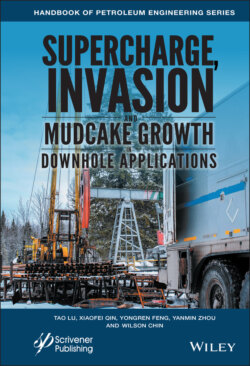Читать книгу Supercharge, Invasion, and Mudcake Growth in Downhole Applications - Группа авторов - Страница 14
1.2 Prototypes, Tools and Systems.
ОглавлениеIn a “handbook” such as this, it is important to provide examples of prototypes, commercial tools and systems. The wide ranges in design parameters can be surprising to newcomers in formation testing. For example, the “vertical and sink probes” in Figure 1.6, which are displaced axially but lie along the same azimuth, can range from six or seven inches to as much as 2.3 ft (27.6 in) and 10.3 ft (123.6 in), where the latter two distances are obtained from the manufacturer’s figure in SPE Paper No. 36176. We might, for example, ask, “Just what does the distant observation probe “see” under different mobility backgrounds?” “Will the tool do the job for my formation?” This book attempts to answer the most obvious questions, but it also aims at providing the tools and software for readers to address those pressing questions that invariably arise in any new logging scenario. To provide a flavor of how hardware literature and specifications might appear, we have included discussion of COSL material related to its standard product lines. Note that COSL’s new “triple probe, 120° tool” (as opposed to a conventional 180° tool) is treated separately in our companion 2021 book.
Close-ups of early single and dual probe prototype formation testers are shown in Figure 1.8. These photographs were obtained during field tests. The black pads shown perform an important sealing function, which prevents leakage of fluid through its contact surface with the sandface. However, they are not as “simple” as they appear. For instance, at any given pump rate, the pressure drop, which depends on nozzle diameter, may be excessive and allow the undesired release of dissolved gas – orifice sizes must be chosen judiciously, as suggested by the wide variety of choices shown in Figure 1.9. The shape of the hole or slot is also important; circular or oval shapes may be acceptable for consolidated matrix rock, but slotted models may be required for naturally fractured media or unconsolidated formations. Of course, in supporting PTA interpretation objectives, the size and shape of a formation tester’s pads must be incorporated into the host math model. More often than not, the model must be simple and mathematically tractable in order to obtain useful answers in a reasonable amount of time. This may require the use of idealized source or sink models, or numerical models with limited numbers of grids in the case of finite difference or finite modeling – consequently, questions related to calibration or geometric factors arise, along with test procedures, etc.
Figure 1.8. Early COSL single and dual probe prototype formation testers (details in 2014 and 2015 books).
Figure 1.9. COSL pad designs with varied sizes and shapes, for different applications, e.g., firm matrix rock, unconsolidated formations, fractured media, and so on..
Pressures obtained in PTA logging are used for multiple applications. For example, depending on the tool, permeability, anisotropy, compressibility and pore pressure are all possible (the term “mobility,” defined as the ratio of permeability to viscosity, is often interchangeably used, assuming that the viscosity is known). The pore pressure itself is used to identify fluids by their vertical hydrostatic gradients; this is possible because changes in pressure are affected by changes in fluid density. Sudden changes in pressure, for instance, may indicate the presence of barriers. However, the raw measured pressure, unless corrected for the “cushioning” effects associated with flowline volume, will not reflect pore pressures accurately. The correction depends, in turn, on the line volume as well as the compressibility and the mobility of the formation fluid. All said, the physics and math can be challenging, but solutions and analytical highlights are presented in the next chapter for a wide variety of tools and applications. Chapter 2 provides a broad state-of-the-art review for source and sink models.
